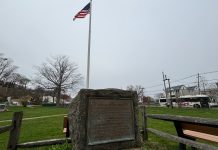By John Burton
Area towns hit by Super Storm Sandy and still working to return to normal are going to get a little extra federal help.
The Federal Emergency Management Agency (FEMA) this week announced it is increasing the amount it will approve for reimbursement to communities for what they have spent on recovery costs from the October storm from 75 percent to 90 percent.
The mayors of towns that will be getting the funds are appreciative of the extra help.
“We’re very pleased,’ said Susan Howard, mayor of Monmouth Beach, one of the shore communities still working to rebuild. “It’s going to make it easier to proceed with the recovery now that our contribution will be 10 percent.”
At the request of Gov. Chris Christie, President Barack Obama this week authorized the increase in the federal cost sharing, according to Maria Pardon, a FEMA spokesperson.
Under federal disaster aid guidelines, when needs meet or exceed a set amount per resident – currently set at $133 per person – the president has the authority to increase the reimbursement to the 90 percent threshold, Pardon said.
The money, earmarked for state and local government and some private not-for-profits, is to offset the cost of emergency expenses, debris removal and infrastructure repairs. The remaining 10 percent will become the responsibility of the state, county and local or private entities, according to FEMA.
“It’ll be happily received by all the towns, especially Highlands,” said Highlands Mayor Frank Nolan, as his town along the Bayshore was one of those significantly damaged by the storm.
Recovery work has been done on a “pay as you go” plan, with local governments then submitting the bills to the federal government, Nolan said
Highlands Borough Council initially bonded $2.5 million for immediate cleanup.
“We’ve only done our most urgent items” so far in Monmouth Beach, as the town evaluates the costs and ways to pay for it, Howard said.
With the additional reimbursement, “it’s going to allow us to go forward with our recovery plans with confidence of what the fiscal impact is,” Howard said.
“We’ve been hoping all along that this event would go to a 90/10 reimbursement,” Sea Bright Mayor Dina Long said. Because its ratable base had been so dramatically impacted by storm damage, Sea Bright has been prioritizing its rebuilding project, “and in some cases pushing them off altogether,” as the town has tried to watch its pennies, Long said. “We’ve been looking at doing things year-by-year, instead of trying to get it all fixed at once.”
With the extra reimbursement funds, a town working on a $1 million project will pay a $100,000 share of costs instead of $250,000. “That’s huge,” Long said, for a town where a penny on the tax rate equates to $44,700. The additional money could be applied to another necessary project.
“It’s an issue of keeping property taxes under control,” Howard said.
Highlands is looking at $10 million to $15 million worth of infrastructure repairs, with a tax base that has decreased by approximately 20 percent from storm damage.
Nolan said his financial people have said the town is looking at taking about 10 years to fully recover.
Sea Bright so far has identified about $10 million in infrastructure repair projects. “We’re still tabulating,” and the price tag is likely to go up, as officials look at its sewer system and seawall repairs and other projects being evaluated, Long said.
So far FEMA has approved more than $556 million in Public Assistance grants for rebuilding communities, according to FEMA-provided information.














